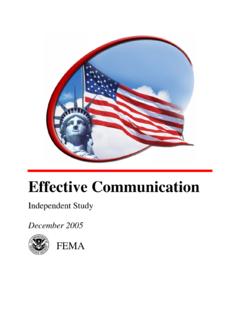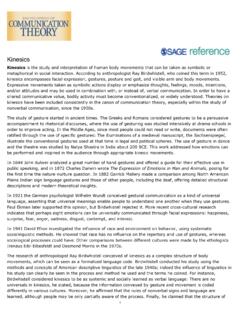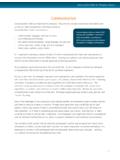Transcription of Ch 5 - Nonverbal Communication
1 Ch 5 - Nonverbal Communication - Chapter Introduction - Recognizing Different Forms Of Nonverbal Communication - Describing How Body Language Affects Negotiations - Describing How The Physical Environment Affects Negotiations - Recognizing How Personal Attributes Affect Negotiations Introduction Communication Is More Than Verbal. Good negotiators must first be good communicators. Unfortunately, many negotiators think of Communication only as oral or written verbal exchanges. But verbal exchanges account for only a fraction of the messages people send and receive. Research has shown that between 70 and 90 percent of the entire Communication spectrum is Nonverbal .
2 Consequently, you should be aware of the different forms of Nonverbal Communication that you are likely to encounter during negotiation conferences. Although we continually send and receive Nonverbal messages, most of us are not fully aware of the ways that we communicate nonverbally. Still, if you watch carefully, you will see that most leading professionals ( , doctors, lawyers, politicians, corporate chief executive officers, and contract negotiators) are excellent Nonverbal communicators. Some people call it charisma. Others call it style. Whatever it is, they have it! Recognizing Different Forms Of Nonverbal Communication Importance of Nonverbal Communication .
3 If you are only aware of` a negotiator's verbal message, you will likely miss the major portion of the overall Communication . Being aware of both Nonverbal and verbal messages will give you an important edge. Skills in interpreting Nonverbal communications will help you glean useful information from others involved in the negotiation. An awareness of Nonverbal Communication may also prevent you from harming your own negotiation position by inadvertently sending Nonverbal signals that disclose confidential information or weaknesses in your position. Areas of Nonverbal Communication . Nonverbal communications include all forms of Communication that are not part of the language that we speak or write.
4 There are many ways that we reveal ourselves nonverbally This text will concentrate on the three areas of Nonverbal Communication that will most likely affect contract negotiations: Body language (kinesic Communication ) using facial expressions, body movements, gestures, and posture;. Physical environment (proxemic Communication ) using available space, distance from or proximity to other people, and territorial control; and Personal attributes such as: o Physical appearance (artifactual Communication ). including all options that communicators use to modify their appearance;. o Vocal cues (auditory Communication ); and o Touch (tactile Communication ) particularly the handshake.
5 Conscious or Subliminal Messages. Nonverbal communications can involve conscious or subliminal messages. Conscious Nonverbal communications. o Senders of conscious Nonverbal communications are aware that they are sending a message and the general meaning of that message. For example, the individuals extending a hug know that they are embracing someone and that action is normally perceived as indicating affection. o Receivers of conscious Nonverbal Communication are aware that they received the message and the meaning intended by the sender. The receiver of a hug, for example, generally realizes that the message is a sign of friendship. Subliminal Nonverbal communications.
6 Subliminal messages are communicated to the subconscious mind of the receiver. Receivers of subliminal messages are not consciously aware of the message. However, these messages are important. o Gut reactions are frequently based upon your subconscious reading of subliminal Nonverbal communications. o Police and military uniforms subliminally communicate the authority of those wearing them. o Well-dressed executives project success and credibility. o Poor dress transmits messages of failure and a lack of credibility. o Although subliminal messages do not create awareness on a conscious level, they still influence the receiver. In fact, subliminal messages are often more powerful than conscious messages.
7 The advertising world is replete with examples of the value of subliminal Nonverbal messages. o Young, beautiful people are often seen in advertisements to communicate the subconscious message that the advertised product is associated with youth and beauty. o Companies pay large sums of money to have their products appear in movies. While these appearances are not typical product advertisements, the mere association of the product with the movie transmits subliminal messages that will influence viewers. Voluntary or Involuntary Messages. Conscious and subliminal messages can both be transmitted voluntarily or involuntarily. Involuntary Nonverbal communications.
8 Most Nonverbal messages are involuntarily. In fact, many negotiators are not aware that they communicate nonverbally. o Body language is one area where the involuntary nature of Nonverbal Communication is particularly evident. Every day, people unintentionally convey Nonverbal signals by their facial expressions, gestures, and body postures. For example, people telling falsehoods often involuntarily send a telltale Nonverbal message to listeners by frequently blinking their eyes. o Because involuntary Nonverbal communications represent unplanned physical responses, this Communication form tends to be particularly revealing and more honest than verbal Communication or even conscious Nonverbal Communication .
9 Voluntary Nonverbal communications. Nonverbal Communication can also be controlled by a knowledgeable person. o A person who knows that people telling falsehoods often blink their eyes can take special care not to blink when telling a falsehood. o A person who knows that a hug indicates friendship can consciously hug his/her worst enemy as trick to put the person off guard or as part of an effort to improve their relationship. Interpreting Nonverbal Messages. You must interpret Nonverbal messages as part of the overall Communication system. Typically, an individual Nonverbal message is difficult to accurately interpret in isolation because most messages have several possible meanings.
10 For example: o A yawn might indicate a lack of interest, physical fatigue, or both. o Rapid eye blinking might indicate deceit or just poor fitting contact lenses. A Nonverbal message is easiest to interpret when it is consistent with other communications that you are receiving at the same time. For example, you might be more likely to interpret rapid eye blinking as indicative of dishonesty if the person also avoids eye contact while speaking. An inconsistent Nonverbal message may be impossible to interpret. However, an apparently negative Nonverbal message should raise a red flag indicating that you should look more carefully for related verbal or Nonverbal clues.

















